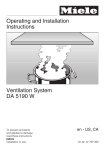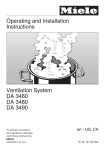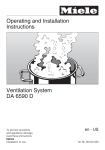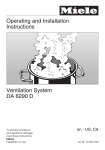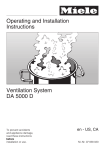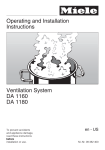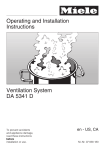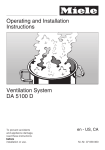Download Miele DA 3190 EXT Technical data
Transcript
Operating and Installation Instructions Ventilation System DA 3160 DA 3180 DA 3190 To prevent accidents and appliance damage, read these instructions before installation or use. en - US, CA M.-Nr. 07 777 910 Contents IMPORTANT SAFETY INSTRUCTIONS. . . . . . . . . . . . . . . . . . . . . . . . . . . . . . . . . 3 Functional description . . . . . . . . . . . . . . . . . . . . . . . . . . . . . . . . . . . . . . . . . . . . . 7 Guide to the Ventilation System . . . . . . . . . . . . . . . . . . . . . . . . . . . . . . . . . . . . . . 8 Operation . . . . . . . . . . . . . . . . . . . . . . . . . . . . . . . . . . . . . . . . . . . . . . . . . . . . . . . 10 Turning the fan on . . . . . . . . . . . . . . . . . . . . . . . . . . . . . . . . . . . . . . . . . . . . . . . . . 10 Selecting the power level . . . . . . . . . . . . . . . . . . . . . . . . . . . . . . . . . . . . . . . . . . . 10 Turning the fan off . . . . . . . . . . . . . . . . . . . . . . . . . . . . . . . . . . . . . . . . . . . . . . . . . 10 Turning the light on and off . . . . . . . . . . . . . . . . . . . . . . . . . . . . . . . . . . . . . . . . . . 11 Cleaning and care . . . . . . . . . . . . . . . . . . . . . . . . . . . . . . . . . . . . . . . . . . . . . . . . 12 Grease filter . . . . . . . . . . . . . . . . . . . . . . . . . . . . . . . . . . . . . . . . . . . . . . . . . . . . . . 13 Inserting / replacing the active charcoal filters . . . . . . . . . . . . . . . . . . . . . . . . . . . 14 Changing the light bulbs . . . . . . . . . . . . . . . . . . . . . . . . . . . . . . . . . . . . . . . . . . . . 15 After Sales Service . . . . . . . . . . . . . . . . . . . . . . . . . . . . . . . . . . . . . . . . . . . . . . . 16 Installation instructions . . . . . . . . . . . . . . . . . . . . . . . . . . . . . . . . . . . . . . . . . . . 17 Caring for the environment . . . . . . . . . . . . . . . . . . . . . . . . . . . . . . . . . . . . . . . . . 19 Appliance dimensions . . . . . . . . . . . . . . . . . . . . . . . . . . . . . . . . . . . . . . . . . . . . . 20 Distance between cooktop and hood (S) . . . . . . . . . . . . . . . . . . . . . . . . . . . . . . . 23 Installation . . . . . . . . . . . . . . . . . . . . . . . . . . . . . . . . . . . . . . . . . . . . . . . . . . . . . . 24 Installation accessories . . . . . . . . . . . . . . . . . . . . . . . . . . . . . . . . . . . . . . . . . . . . . 24 1. Installing the space bar . . . . . . . . . . . . . . . . . . . . . . . . . . . . . . . . . . . . . . . . . . . 27 2. Runners . . . . . . . . . . . . . . . . . . . . . . . . . . . . . . . . . . . . . . . . . . . . . . . . . . . . . . . 28 3. Installing the hood in the cabinet. . . . . . . . . . . . . . . . . . . . . . . . . . . . . . . . . . . . 28 4. Secure the appliance. . . . . . . . . . . . . . . . . . . . . . . . . . . . . . . . . . . . . . . . . . . . . 30 5. Install the front panel if necessary . . . . . . . . . . . . . . . . . . . . . . . . . . . . . . . . . . . 31 6. Install the grease filter . . . . . . . . . . . . . . . . . . . . . . . . . . . . . . . . . . . . . . . . . . . . 32 7. Venting . . . . . . . . . . . . . . . . . . . . . . . . . . . . . . . . . . . . . . . . . . . . . . . . . . . . . . . . 32 8. Electrical connection . . . . . . . . . . . . . . . . . . . . . . . . . . . . . . . . . . . . . . . . . . . . . 33 Air extraction . . . . . . . . . . . . . . . . . . . . . . . . . . . . . . . . . . . . . . . . . . . . . . . . . . . . 34 Electrical connection . . . . . . . . . . . . . . . . . . . . . . . . . . . . . . . . . . . . . . . . . . . . . . 36 Technical data . . . . . . . . . . . . . . . . . . . . . . . . . . . . . . . . . . . . . . . . . . . . . . . . . . . 37 2 IMPORTANT SAFETY INSTRUCTIONS READ AND SAVE THESE INSTRUCTIONS Keep these instructions in a safe place and pass them on to any future user. Read these instructions carefully before installing or using the Ventilation System. ~ This appliance is intended for residential use only. Use the appliance only for its intended purpose. ~ This appliance complies with current safety requirements. Improper use of the appliance can lead to personal injury and material damage. ,CAUTION For General Ventilating Use Only. Do Not Use To Exhaust Hazardous Or Explosive Materials And Vapors. ~ This appliance is designed to vent cooking smoke and odors only. ~ This appliance is suitable for installation above gas or electric cooking surfaces. ,WARNING TO REDUCE THE RISK OF FIRE, ELECTRIC SHOCK, OR INJURY TO PERSONS, OBSERVE THE FOLLOWING: ~ a) Use this appliance only in the manner intended by the manufacturer. If you have questions, contact Miele. ~ b) Before servicing or cleaning the appliance, switch power off at the service panel and lock the service disconnecting means to prevent power from being switched on accidentally. If the service disconnecting means cannot be locked, securely fasten a prominent warning device, such as a tag, to the service panel. ~ c) Be certain your appliance is properly installed and grounded by a qualified technician. To guarantee the electrical safety of this appliance, continuity must exist between the appliance and an effective grounding system. It is imperative that this basic safety requirement be met. If there is any doubt, have the electrical system of the house checked by a qualified electrician. ~ This appliance is not designed for maritime use or for use in mobile installations such as recreational vehicles or aircraft. However, under certain conditions installation in these applications may be possible. Please contact your Miele dealer or the Miele Technical Service Department with specific requirements. 3 IMPORTANT SAFETY INSTRUCTIONS ~ d) Before connecting the appliance to the power supply make sure that the voltage and frequency listed on the data plate correspond with the household electrical supply. This data must correspond to prevent appliance damage. If in doubt consult a qualified electrician. ~ e) Installation work and repairs should only be performed by a qualified technician in accordance with all applicable codes and standards. Repairs and other work by unqualified persons could be dangerous. ~ f) Only open the housing as described in the enclosed "Installation diagram" and in the "Cleaning and care" section of this manual. Under no circumstances should any other parts of the housing be opened. Tampering with electrical connections or components and mechanical parts is highly dangerous to the user and can cause operation faults. ~ g) Before discarding an old appliance, disconnect it from the power supply and remove the power cord to prevent hazards. 4 Use ,WARNING TO REDUCE THE RISK OF A COOKTOP GREASE FIRE: ~ a) Never leave surface units unattended at high settings. Boilovers cause smoking and greasy spillovers may ignite. Heat oils slowly on low or medium settings. ~ b) Always turn the hood on when cooking at a high heat. ~ c) Clean the ventilation hood frequently. Grease should not be allowed to accumulate on the fan or filter. ~ d) Use the proper pan size. Always use cookware appropriate for the size of the cooking area. ~ e) Do not flambé or grill with an open flame beneath the hood. Flames could be drawn up into the hood by the suction and the grease filters may catch fire. IMPORTANT SAFETY INSTRUCTIONS ,WARNING TO REDUCE THE RISK OF INJURY TO PERSONS IN THE EVENT OF A COOKTOP GREASE FIRE, OBSERVE THE FOLLOWING*: ~ Do not allow children to play with or ~ a) SMOTHER FLAMES with a close fitting lid, cookie sheet, or metal tray then turn off the burner. BE CAREFUL TO PREVENT BURNS. If the flames do not go out immediately, EVACUATE AND CALL THE FIRE DEPARTMENT. ~ Never operate gas burners without ~ b) NEVER PICK UP A FLAMING PAN - You may be burned. operate the appliance or its controls. Supervise its use by the elderly or infirm. ~ Always turn on the hood when using the cooktop to prevent damage from condensation. cookware. Turn the burner off when not in use. Adjust the burner so that the flames do not extend beneath the cookware. Do not overheat the cookware, e.g. when using a wok. The hood can be damaged due to excessive heat from the burners and the cookware. ~ c) DO NOT USE WATER, including wet dishcloths or towels - a violent steam explosion will result. ~ Do not use the hood without the ~ d) Use a fire extinguisher ONLY if: the hood. Steam could penetrate electrical components and cause a short circuit. 1) You have a class ABC extinguisher, and you know how to operate it. grease filters in place. ~ Do not use a steam cleaner to clean 2) The fire is small and contained in the area where it started. 3) The fire department is being called. 4)You can fight the fire with your back to an exit. * Based on "Kitchen Firesafety Tips" published by NAFTA 5 IMPORTANT SAFETY INSTRUCTIONS Installation ~ g) Do not install this hood over cooktops that burn solid fuel. ,WARNING TO REDUCE THE RISK OF FIRE, ELECTRIC SHOCK, OR INJURY TO PERSONS, OBSERVE THE FOLLOWING: ~ a) Installation work and electrical wiring must be done by qualified person(s) in accordance with all applicable codes and standards, including fire-rated construction. ~ b) Sufficient air is needed for combustion and exhausting of gases through the flue (chimney of fuel burning equipment to prevent back drafting. Follow the heating equipment manufacturer’s guideline and safety standards such as those published by the National Fire Protection Association (NFPA) and the American Society for Heating, Refrigeration and Air Conditioning Engineers (ASHRAE), and the local code authorities. ~ c) When cutting or drilling into the wall or ceiling, do not damage electrical wiring and other hidden utilities. ~ d) Ducted hoods must always be vented to the outdoors. ~ e) Do not use this hood with any solid-state speed control device. ~ f) Do not use an extension cord to connect the appliance to electricity. Extension cords do not guarantee the required safety of the appliance, (e.g. danger of overheating). 6 ~ h) Provided a larger distance is not given by the manufacturer of the cooktop, follow the minimum safety distances between a cooktop and the bottom of the hood given in the "Appliance dimensions" section of this manual. If local building codes require a greater safety distance, follow their requirement. If there is more than one appliance beneath the hood and they have different minimum safety distances always select the greater distance. ~ i) Never connect an exhaust hood to an active chimney, dryer vent, vent flue, or room ventilating ductwork. ~ j) Seek professional advice before connecting an exhaust hood vent to an existing, inactive chimney or vent flue. ~ k) Any fittings, sealant, or materials used to install the ductwork must be made of approved non-flammable materials. ,WARNING TO REDUCE THE RISK OF FIRE USE ONLY METAL DUCTWORK. Functional description The ventilation hood offers two modes of operation: Air extraction Recirculation mode The air is drawn in and cleaned by the grease filters and directed outside. Air is drawn through the grease filters and an active charcoal filter. The filtered air is then recirculated back into the kitchen. The hood comes equipped with a non-return flap. The flap automatically closes when the hood is turned off so that no exchange of outside air and room air can occur. When the hood is turned on, the air pressure of the exhaust fan automatically opens the flap blowing the inside air and cooking odors outside. The recirculation mode requires an install kit and charcoal filter which are optional accessories. Before using the hood in recirculation mode, ensure that the active charcoal filter is in place, see "Cleaning and care". 7 Guide to the Ventilation System 8 Guide to the Ventilation System a Vent connection b Control panel c Grease filter d Expandable fume deflector e Overhead cooktop light f Active charcoal filter Optional accessory for recirculation mode g Facia Panel Accepts a custom front panel with the DML 300 kit, optional accessory h On/Off button i Power level buttons Four fan speed selection j Light button 9 Operation Turning the fan on Fan performance ^ Pull the deflector out. The maximum air flow capacity is 625 cfm. Factors such as narrow duct diameter and bends will affect this value. The hood will operate at power level "2". The On/Off indicator and the second "-/+" indicator will light. Selecting the power level Depending on how much the air needs to be filtered, there are four power levels available. Level 1 operates at 40% capacity Level 2 operates at 60% capacity Level 3 operates at 80% capacity Level 4 operates at 100% capacity There will also be a slight decrease in airflow for hoods operated in recirculation mode due to the active charcoal filter. Turning the fan off ^ Use the "-/+" buttons to select the power level required. The indicators show which power level has been chosen. For normal cooking a low to medium level is usually sufficient. For frying or cooking food with a strong aroma use the highest level. Pull the deflector all the way out to ensure an optimal intake of cooking odors. 10 ^ Push the deflector back in. The next time the deflector is pulled out, the hood will operate on power level "2". or ^ Press the On/Off button to turn the fan off. The indicators go out. Operation Automatically switching back the Intensive power level The intensive level "4" can be programmed to automatically switch back to level "3" after 10 minutes. ^ Turn the fan and the lights off. Turning the light on and off The light for illuminating the cooktop can be turned on or off independently of the fan. ^ Pull the deflector out to turn the light on. Push it in to turn it off. or ^ Press and hold the "-/+" buttons for 10 secs. The first indicator of the fan power levels lights. ^ Press the following buttons one after another, ^ Press the light button. When the light is turned on the indicator next to the button illuminates. ^ Press the light button again. – light, The indicator will go out. – the "-" button, and – the light button again. If the power level indicators flash the automatic switch back is not activated. ^ To activate the automatic switch back press the "+" button. The power level indicators "1" and "4" light. ^ To deactivate the automatic switch back press the "–" button. ^ To save the setting press the On/Off button. 11 Cleaning and care ,WARNING TO REDUCE THE RISK OF FIRE, ELECTRIC SHOCK, OR INJURY TO PERSONS, OBSERVE THE FOLLOWING: Before cleaning or servicing the hood, disconnect it from the power supply, see "Important Safety Instructions". Avoid: – cleaning agents containing soda, acids or chlorides, – abrasive cleaning agents e.g. powder or cream cleansers, – abrasive sponges, e.g. pot scourers or sponges which have been previously used with abrasive cleaning agents. These will damage the surface. Cleaning the casing Never use abrasive cleaners, scouring pads, steel wool or caustic (oven) cleaners on the hood. They will damage the surface. The following instructions for cleaning "Stainless steel" surfaces and "Stainless steel colored controls" should be followed in addition to the general "Cleaning the casing" instructions. ^ All external surfaces and controls can be cleaned with a mild solution of warm water and liquid dish soap applied with a soft sponge. Stainless steel surfaces ^ Wipe dry using a soft cloth. To help prevent resoiling, a conditioner for stainless steel can be applied. Do not use too much water when cleaning the controls. Water could penetrate the electronics and cause damage. 12 Stainless steel surfaces can be cleaned using a non-abrasive stainless steel cleaner. Stainless steel colored controls These controls may become discolored or damaged if not cleaned regularly. Do not use a stainless steel cleaner on these controls. Cleaning and care Grease filter Cleaning the filter The reusable metal grease filter removes solid particles from the vented kitchen air (grease, dust, etc). ^ By hand: use a scrub brush with a solution of warm water and mild detergent. Do not use the pure detergent, aggressive all purpose cleaners, oven sprays, abrasive cleaning agents or limescale removers. They could destroy the filter. The grease filter should be cleaned every 3 - 4 weeks. ,A dirty filter is a fire hazard. ^ To remove hold and pull out the deflector and the grease filter together. ^ Pull the grease filter downwards and out. Support the grease filter so that it does not fall onto the cooktop. ^ In a dishwasher: place the filter vertically in the lower basket, making sure that the spray arm is not blocked. Use a wash program with a max. temperature of 150°F (65°C). In a Miele dishwasher use the "Normal" program. Use the recommended amount of dishwasher detergent. Overuse could destroy the filter. Depending on the detergent, cleaning the grease filter in a dishwasher may cause permanent discoloration of the filter surface. Performance of the filter will not be affected by this discoloration. ^ After cleaning, the filter can be placed on a towel to air dry. ^ Turn the hood off. ^ While the filter is removed, clean any dirt or grease from the filter casing to prevent the risk of fire. 13 Cleaning and care Inserting / replacing the active charcoal filters For recirculation mode an active charcoal filter must be used in addition to the grease filter. The charcoal filter is designed to absorb cooking odors. The active charcoal filter is inserted above the grease filter. ^ To insert the grease filter, make sure that the red plastic guides are at the front and facing up. ^ Insert the grease filter in the deflector and push upwards. It should glide onto the fixing pins. ^ Replace the filter every 6 months or when it is no longer absorbing cooking odors. Replacement active charcoal filters can be ordered from Miele. ^ Follow the instructions supplied with the active charcoal filter. ^ Dispose of the charcoal filter with the household waste. 14 Cleaning and care Changing the light bulbs ,WARNING TO REDUCE THE RISK OF FIRE, ELECTRIC SHOCK, OR INJURY TO PERSONS, OBSERVE THE FOLLOWING: Before changing the light bulbs, disconnect the hood from the power supply, see "Important Safety Instructions". When in use halogen bulbs become extremely hot, use caution. Do not attempt to change the bulbs until they have had sufficient time to cool. Do not touch the bulb surface. Fingerprints or body oils deposited on the bulb will decrease its life. Follow the bulb manufacturer’s instructions. ^ Pull the deflector out and remove the grease filter as described in "Cleaning and Care - Grease filter". ^ Reach through the grille opening and push the light fixture downwards. ^ Turn the bulb counterclockwise and pull it out of its socket. ^ Replace the bulb with a new one in the reverse order and push upwards. ^ Return the grease filter and if existent the active charcoal filter. ^ Remove the active charcoal filter if existent. 15 After Sales Service Repairs MieleCare In the event of a fault which you cannot easily fix yourself, please contact the Miele Technical Service Department. (USA only) ^ When contacting the Technical Service Department, please quote the model and serial number of your appliance. These are shown on the data plate which is visible when the grease filters are removed. MieleCare, our Extended Service Contract program, gives you the assurance of knowing that your appliance investment is covered by 5 years of worry free ownership. MieleCare is the only Extended Service Contract in the industry that guarantees repairs by a Miele Authorized Service Provider using genuine Miele parts. Only genuine Miele parts installed by factory trained professionals can guarantee the safety, reliability, and longevity of your Miele appliance. Please note that unless expressly approved in writing by Miele’s Service department, Extended Service Contracts offered by other providers for Miele products will not be recognized by Miele. Our goal is to prevent unauthorized (and untrained) service personnel from working on your Miele products, possibly doing further damage to them, you and/or your home. To learn more about MieleCare Extended Service Contracts, please contact your appliance dealer or visit us online at: http://miele.com/mielecare 16 Installation Instructions Read these instructions and the "Important Safety Instructions" before installing this hood. Leave these instructions with the appliance for the comsumer/user. Information is subject to change. Please refer to our website to obtain the most current product specification, technical & warranty information. 18 Caring for the environment Disposal of packing material Disposal of an old appliance The cardboard box and packing materials protect the appliance during shipping. They have been designed to be biodegradable and recyclable. Please recycle. Old appliances may contain materials that can be recycled. Please contact your local recycling center about the possibility of recycling these materials. ,DANGER Ensure that any plastic wrappings, bags, etc., are disposed of safely and kept out of the reach of babies and young children. Danger of suffocation! Before discarding an old appliance, disconnect it from the electrical supply and cut off the power cord to prevent it from becoming a hazard. 19 Appliance dimensions 20 Appliance dimensions * The hood can also be installed in a 23 5/8" (60 cm) cabinet. 21 Appliance dimensions * The hood can also be installed in a 23 5/8" (60 cm) cabinet. 22 Appliance dimensions 1) Air extraction mode; consider accessories when measuring cabinet height and cut-outs (e.g. muffler). 2) Recirculation mode with Installation kit DUU 151 Distance between cooktop and hood (S) Do not install this exhaust hood over cooktops burning solid fuel. Provided a larger distance is not given by the manufacturer of the cooktop, follow the minimum safety distances between a cooktop and the bottom of the hood: Miele Cooktops Non-Miele Cooktops Electric Cooktops 24" (610 mm) Electric Barbeques and Fryers 26" (660 mm) Multiburner Gas cooktops < 43,000 BTU (12.6 KW) and no burner > 15,000 BTU (4.5 KW) 26" (660 mm) 30" (760 mm) Single burner (Wok) < 20,500 BTU (6 KW) 26" (660 mm) 30" (760 mm) All other gas cooktops 30" (760 mm) – If several gas surfaces are installed under the hood, the total output must be considered when determining the minimum safety distance. – If installing the exhaust hood in an overhead cabinet or if using a front panel made of wood or plastic, observe the instructions of the manufacturer of the gas cooktop regarding the use of flammable materials above the cooktop. If not otherwise specified in the instructions, ensure a distance of at least 30” (762 mm) from the gas cooktop. – If local building codes require a greater safety distance, follow their requirement. – If there is more than one appliance beneath the hood and they have different minimum safety distances always select the greater distance. See "Important Safety Instructions" for further information. 23 Installation Installation accessories 24 Installation a 2 runners (1 x right, 1x left) to support the hood in the cabinet. b 1 spacer strip to conceal the gap between the rear of the appliance and the wall. c Installation kit for recirculation mode; contains air outlet grille, hose and hose clips (optional accessory) d Installation kit DML 300 to install a custom panel contains retractable brackets and screws ( optional accessory) ,CAUTION To avoid risk of hand or other injury, avoid contact with sharp edges during the assembly and installation process. 8 screws 3.5 x 16 mm to anchor the ventilation hood in the cabinet. 8 screws M4 x 12 mm to anchor the ventilation hood at the runners. 4 screws could be used (alternatively to the plastic rivet) to fix the spacer bar. 2 screws 4 x 30 mm to anchor the ventilation hood at rear wall. 4 plastic rivets to connect the space bar with the appliance rear wall. 25 Installation 26 Installation 1. Installing the space bar T = K cabinet depth minus G hood depth ^ The hood depth G depends on the custom panel: – a Hood installed with a cabinet matching custom panel – b Hood installed without front panel These measures are only valid for the installation if the front panel sits flush with the cabinet corpus (without the door). ^ Screw the space bar flush with the wall under the cabinet side walls. If the front panel should be installed recessed or flush with the cabinet door, adjust the measure T accordingly. ^ Cut the supplied space bar to measure T. Clip it with a knife at the predetermined breaking point of the next lower measure. ^ At the front edge of the spacer strip draw a vertical line on left and right side of the inside cabinet. 27 Installation 2. Runners 3. Installing the hood in the cabinet ^ Lay the hood on its back side. Do not remove the installation protector between the deflector and casing before the installation is completed. The runners are made for side walls of 5/8" (16 mm) and 3/4" (19 mm). Screw on the angled side which has the imprint of the respective cabinet wall measure. ^ Align the runners with the drawn line and be sure that they are flush with the lower edge of the cabinet side wall. Screw the runners on the left and right side in the cabinet. ^ Hold the grease filter and pull it out along with the deflector. 28 Installation ^ Take the grease filter out and put it aside. ^ Push the deflector back in. ^ Insert the hood into the cabinet from below and until the spring clips click into place. ^ When installing a 29 13/16" (80 cm) or a 35 1/4" (90 cm) hood into a 23 5/8" (60 cm) cabinet, unscrew the deflector spring clips while the deflector is pulled out. ^ To dismount the appliance: unscrew the screws to the left and the right of the inner side of the hood. The installation springs loosen and the hood can be removed from the cabinet. 29 Installation 4. Secure the appliance ^ Push the hood back so it sits flush with the front of the spacer strip. ^ Pull the deflector out. ^ Drill respective holes and screw the fixing brackets to the wall or the cabinet rear wall. ^ Screw the hood, with 4 screws, onto the runners. ^ Tighten the screws to the casing. ^ Remove the installation protection between the deflector and casing. ^ Connect the space bar from the rear with 4 plastic rivets at the hood rear side. ^ Loosen the screws of the fixing brackets on the hood top. ^ Push the bracket flush to the wall or the cabinet back wall. 30 Installation 5. Install the front panel if necessary The installation kit DML 300 is necessary. It can be obtained as an optional accessory from Miele. The installation kit has an installation manual supplied. Weight of the front panel ^ The deflector can be adjusted up to 2" (50 mm) towards the front with the two adjusting screws left and right in the deflector. Adjust the deflector until it is flush with the front of the adjacent cabinetry. The weight of the front panel must not exceed 2.8 lbs (1.3 kg). This applies for front panels with a depth of up to 1 1/4" (30 mm). In the case of front panels of greater depth or greater weight, the weight must be reduced by milling out the back of the panel, for instance. 31 Installation 6. Install the grease filter 7. Venting Air extraction mode ^ Complete the venting installation, see "Air extraction". Recirculation mode ^ Remove the protective film from the grease filter frame. ^ To reinsert the grease filter, pull the deflector out. If the hood cannot be installed for air extraction the appliance must be connected for recirculation mode. For recirculation mode a respective installation kit is recommended which can be obtained from Miele. In addition an active charcoal filter is needed. ^ Make sure that the red plastic guides are at the front and facing up. ^ Insert the grease filter into the deflector, and push upwards. It should glide onto the fixing pins. 32 ^ The non-return flap is not needed for the recirculation mode. Pull the non-return flap off the bracket from the vent connection. Installation 14 3 8. Electrical connection 31 Refer to the notes in "Electrical connection" and "Important Safety Instructions" before connecting to the mains. 9 10 ^ Plug in the power cord. 24 90 11 0 0 22 3 40 33 160 0 15 ^ Install the installation kit as described in the manual supplied with the kit. ^ Make sure that the slats in the grill point towards the center of the room and not towards a wall or the ceiling. ^ Install the Active Charcoal Filter (see "Cleaning and care"). 33 Air extraction ,WARNING Danger of toxic fumes. Gas cooking appliances release carbon monoxide that can be harmful or fatal if inhaled. To reduce the risk of fire and to properly exhaust air, the exhaust gases extracted by the hood should be vented outside of the building only. Do not vent exhaust air into spaces within walls or ceilings or in attics, crawl spaces or garages. To reduce the risk of fire, only use metal ductwork. Please read and follow the "IMPORTANT SAFETY INSTRUCTIONS" to reduce the risk of personal injury. Follow all local building codes when installing the hood. Exhaust ducting and connections Use smooth or flexible pipework made from approved non-flammable materials for exhaust ducting. To achieve the most efficient air extraction and quietest noise levels, consider the following: – The diameter of the ductwork should not be less than 6" (150 mm). – If flat ducting is used, the cross section must not be smaller than the cross section of the ventilation exhaust. – The ducting should be as short and straight as possible. – Use ductwork with a wide radius. – The exhaust duct must not be bent or compressed. – Make sure all connections are secure. – Where the ductwork is horizontal, it must slope away from the hood at least 1/8" per foot (1 cm per meter) to prevent condensation dripping into the appliance. – If the exhaust is ducted through an outside wall, a Telescopic Wall Vent can be used. 34 Air extraction Condensate trap optional accessory In some cases, a condensate trap may also be required to collect and evaporate any condensate which may occur. This optional accessory is available for ducts 5" (125 mm) and 6" (150 mm) in diameter. – If the exhaust is ducted into an inactive flue, the air must be expelled parallel to the flow direction of the flue. Never connect an exhaust hood to an active chimney, dryer vent, flue, or room venting ductwork. Seek professional advice before connecting an exhaust hood vent to an existing, inactive chimney or vent flue. ^ When installing a condensate trap, ensure that it is positioned vertically and if possible directly above the exhaust outlet. Important If the ductwork runs through rooms, ceilings, garages, etc. where temperature variations exist, it may need to be insulated to reduce condensation. 35 Electrical connection ,WARNING TO REDUCE THE RISK OF FIRE, ELECTRIC SHOCK, OR INJURY TO PERSONS, OBSERVE THE FOLLOWING: All electrical work should be performed by a qualified electrician in strict accordance with national regulations (for USA: ANSI-NFPA 70) and local safety regulations. Installation, repairs and other work by unqualified persons could be dangerous. Ensure that power to the appliance is OFF while installation or repair work is performed. ^ Verify that the voltage, load and circuit rating information found on the data plate (located behind the grease filters), match the household electrical supply before installing the hood. ^ Use only with ventilation hood cord-connection kits that have been investigated and found acceptable for use with this model hood. If there is any question concerning the electrical connection of this appliance to your power supply, please consult a licensed electrician or call Miele’s Technical Service Department. ,WARNING: THIS APPLIANCE MUST BE GROUNDED 36 Grounding Instructions This appliance must be grounded. In the event of an electrical short circuit, grounding reduces the risk of electric shock by providing a path of least resistance. This appliance is equipped with a cord having a grounding wire with a grounding plug. The plug must be plugged into an outlet that is properly installed and grounded. WARNING - Improper grounding can result in a risk of electric shock. If there is any doubt, have the electrical system of the house checked by a qualified electrician. Do not use an extension cord. If the power supply cord is too short, have a qualified electrician install an outlet near the appliance. Important The hood comes equipped with a 4 ft (1.2 m) power cord with a NEMA 5-15 molded plug for connection to a 120 VAC, 60 Hz, 15 A power outlet. Technical data Maximum load . . . . . . . . . . . . . . . 450 W Light. . . . . . . . . . . . . . . . . . . . . 2 x 50 W Voltage . . . . . . . . . . . . . . . . . . . . . 120 V Frequency . . . . . . . . . . . . . . . . . . 60 Hz Circuit rating. . . . . . . . . . . . . . . . . . 15 A Weight DA 3160 . . . . . . . . . . . 27.6 lb (12.5 kg) DA 3180 . . . . . . . . . . . 29.8 lb (13.5 kg) DA 3190 . . . . . . . . . . . . . 32 lb (14.5 kg) 37 38 39 Alteration rights reserved / 0910 M.-Nr. 07 777 910 / 01 INFORMATION IS SUBJECT TO CHANGE. PLEASE REFER TO OUR WEBSITE TO OBTAIN THE MOST CURRENT PRODUCT SPECIFICATIONS, TECHNICAL & WARRANTY INFORMATION.








































